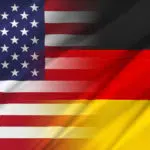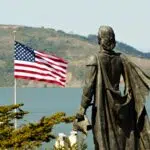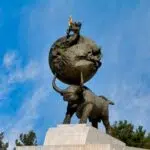Besides being a great excuse to eat bratwurst and drink beer like there’s no tomorrow, German-American Day on October 6th honors the anniversary of the first German immigrants arriving in America. Since they touched down and created Germantown in Pennsylvania, German immigrants and their descendants have had a massive impact on American culture and history. From starting the first Kindergartens to giving us the legend of Santa Claus, Germans contributed more than you might know! Today, we’re celebrating the culture and brushing up on the history of Germans in America.
History of NATIONAL GERMAN-AMERICAN DAY
German-Americans have been in America since the very beginning. In 1608, there were several Germans among the Jamestown settlers. German immigrants arrived in more significant numbers around 1670, when they chose to settle overwhelmingly in Pennsylvania and New York. In Pennsylvania, Germans famously founded Germantown and Pennsylvania still has the largest amount of German-Americans in the country.
Between 1820 and World War 1, the largest influx of German immigrants arrived. Many sought political or religious freedom after the German Revolutions of 1848, prompting other Americans to call them “Forty- Eighters.” German immigrants began to venture out into the Midwest, where they heavily populated Chicago, Milwaukee, Cincinnati, and more major cities. During the Civil War, many Germans enlisted and fought on the Union side, as the general sentiment in German culture was anti-slavery.
It was in these earlier years of German immigration to America that much of the cultural influence we see today took place. For example, during this time, Germans brought the custom of Christmas trees, the delicious hamburger and the pretzel, and even kindergarten. German culture stressed the importance of universal education, which heavily influenced the budding American education system. German entrepreneurs, like Steinway and Studebaker, developed businesses whose products, like pianos and covered wagons, helped define important eras in American life.
World War 1 was a rough time for German-Americans. The anti-German sentiment caused politicians to worry that German-Americans would have split loyalties and undermine American war efforts – even the President doubted the loyalty of those with “hyphenated Americanism.” Germans were not allowed to even volunteer at the Red Cross, and many German music pieces and other art were not performed or displayed. During World War II, over 110,000 Germans fled their home country and sought refuge from oppression in America. Many Germans were interned and their civil rights violated.
By 1970, the anti-German sentiment had mostly evaporated, and German-Americans found many similarities with other Western European immigrants. Today, many German-American cultural contributions are so heavily assimilated with American culture that many people couldn’t pick them out if they tried. German-Americans now make up the largest self-reported ancestry group, which is around 44.2 million.
NATIONAL GERMAN-AMERICAN DAY timeline
Jamestown, the first English colony settled in 1608, was the home to several of the first German immigrants to America.
Following the German Revolutions of 1848, nearly a million Germans flooded into America seeking political and religious freedom.
The 1948 Displaced Persons Act made it easier for displaced Germans to come to the US.
Established by presidential proclamation and Congressional approval, German-American day was passed in 1987 to honor the contribution over centuries of German-Americans.
NATIONAL GERMAN-AMERICAN DAY FAQs
Is there a Germany Day?
German Unity Day (German: Tag der Deutschen Einheit) is the National Day in Germany, celebrated on 3 October as a public holiday.
What does it mean to be German-American?
German Americans are citizens of the United States who were either born in Germany or are of German ancestry. They comprise about 50 million people, making them the largest ancestry group ahead of Irish Americans, African Americans and English Americans.
What is the most German city in America?
The city of New Ulm calls itself “the most German town in America.” New Ulm was founded by two groups of German immigrants in the mid-1850s, both looking to create a “Utopian German community.” Today, 66% of its residents claim German ancestry.
NATIONAL GERMAN-AMERICAN DAY Activities
Learn the history of Germans in America
German immigrants were already settling in the British colonies by 1670, and they have made significant contributions to our government, business landscape, and culture since. Understanding how Germans have shaped the America we know today is a great way to observe National German-American Day!
Go out for some German cuisine
If you can’t whip up the most authentic bratwurst and sauerkraut, head out to a restaurant that can! No need to decide between currywurst and schnitzel - have them both.
Post #GermanAmericanDay on social media
Whether it’s a clip of you trying to remember the German phrases you learned in high school, or just a picture of the homemade käsespätzle you made, share it with the hashtag #GermanAmericanDay to inspire some other German-Americans to share their culture and histories.
Germans avoided public office
German-American tended to avoid politics altogether, even though Germans had populated America since its earliest days, the first President with a German surname was Eisenhower in 1952.
Into the New Year, guns blazing
An interesting German tradition that remained strong in German communities throughout America was the New Year’s tradition of riding around firing shoguns at midnight.
The first American brewery was established by Germans
In 1829, a German immigrant founded D.G. Yuengling & Son in Pottsville, PA. Their flagship beer is still a German lager!
There are famous German-Americans
As the largest ancestry group, there’s no wonder some celebs proudly share their German heritage! German-American stars include Uma Thurman, Heidi Klum, Kristen Dunst, Leo DiCaprio, and more.
There is a “German Belt”
Consisting of cities and states with notable German influence and population, the German Belt extends from the Oregon coast to Pennsylvania and includes cities like Germantown, PA.
Why We Love NATIONAL GERMAN-AMERICAN DAY
It celebrates German culture
Fans of hamburgers and beer that we are, we’re glad Germans came to America over 300 years ago. Other pieces of German culture adopted by Americans include weekends, theme parks, Santa Claus, and the tuba!
They’re an important group in American history
German culture is so pervasive in America today that we sometimes overlook where it came from. Many don’t know that our education system and the notion of universal education was largely influenced by the Germans, and we wouldn’t have the Easter Bunny without their cultural traditions. Beyond this, many German-Americans became important entrepreneurs and leaders.
It’s a chance to learn the language
Who hasn’t thought about learning another language? In between light, fizzy German beers, it’s fun to let someone else at the party teach you some basic German phrases!
NATIONAL GERMAN-AMERICAN DAY dates
| Year | Date | Day |
|---|---|---|
| 2025 | October 6 | Monday |
| 2026 | October 6 | Tuesday |
| 2027 | October 6 | Wednesday |
| 2028 | October 6 | Friday |
| 2029 | October 6 | Saturday |































